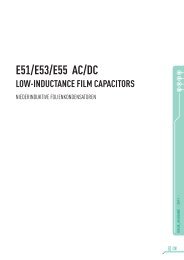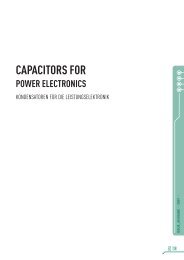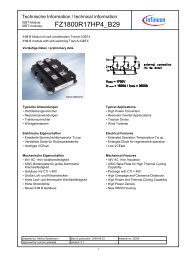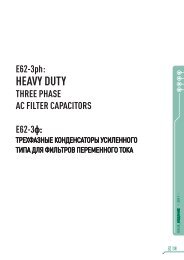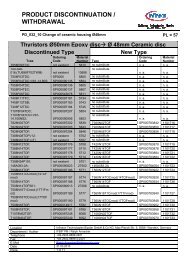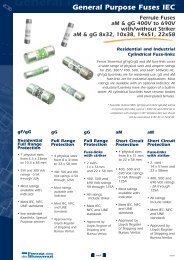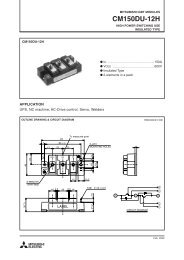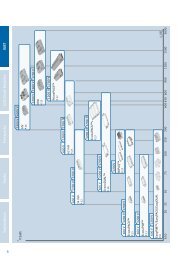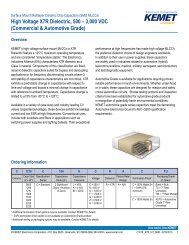Quality Policy
Quality Policy
Quality Policy
- No tags were found...
You also want an ePaper? Increase the reach of your titles
YUMPU automatically turns print PDFs into web optimized ePapers that Google loves.
General Technical InformationCAPACITOR CONSTRUCTIONBasic Construction of a CapacitorThe basic principle of the capacitor is to store electrical charge(Q in coulombs). The potential charge it can hold is determinedby the capacitance (C in Farads) and voltage (V in volts) and isdefined as:Q = C . VThe unit of capacitance, the Farad, is the capacitance of thecapacitor between the plates across which there appears apotential difference of 1 volt when it is charged by 1 coulombof electricity. The value of capacitance in a basic capacitor isproportional to the area of the plates and inversely proportional tothe distance between them. Not only does this distance betweenthe plates have an effect on capacitance but also the material thatoccupies the space, known as the dielectric.Aluminium Electrolytic CapacitorsThe aluminium electrolytic capacitor consists basically of twofoils interleaved with an absorbent paper wound tightly into acylinder. The main advantage of this type of capacitor is the highcapacitance per unit volume due to its internal construction whichconsists of a very thin dielectric layer and large effective surfacearea.The positive plate, or anode, is made from aluminium foil whichis etched to increase the surface area. The dielectric is aluminiumoxide, which is formed electrolytically onto the surface of thefoil. This formed oxide layer is very thin, being proportional inthickness to the forming voltage and possesses a semiconductorcharacteristic. The oxide thickness for a 25 volt working capacitoris in the order of 0.045 microns.+veA = surface areadielectriccathodedielectricd-vealuminium foilIf the space were to be occupied by a perfect vacuum then thecapacitance can be determined by:∈ 0 . AC =dA = surface area of the plates in m 2d = distance between the plates(or dielectric thickness) in m∈ 0= permittivity of free space - 8.85 x 10 -12 F/mIn practice this space is occupied by a dielectric which has arelative permittivity to that of the vacuum as follows:Material Relative PermittivityVacuum 1.0Air 1.0006Paper (dry) 2 - 2.5Polythene 2 - 2.5Insulating oil 3 - 4Bakelite 4.5 - 5.5Glass 5 - 10Therefore capacitance is determined by:∈ 0. ∈ r. AC =d∈ r= relative permittivity of the dielectricThe negative plate, or cathode, is provided by an electrolytesolution for two reasons:• allows good contact with the anode by permeating all theetched structure.• repairs any flaws in the oxide layer when the capacitor ispolarised.The second foil, usually called the cathode foil, contacts withthe electrolyte reducing the series resistance. This foil has a thinstabilized oxide film, and therefore will also possess a very highcapacitance. Like the anode foil the cathode is also etched toincrease the surface area. This is necessary in order to eliminatethe effect on the overall capacitance by the presence of thecathode foil.equivalent circuitanodealuminium foilpaper soaked in electrolyteelectrolyte solutionanodecathode1 1 1C total=C anode+C cathodeKEMET Electrolytic Capacitors13



